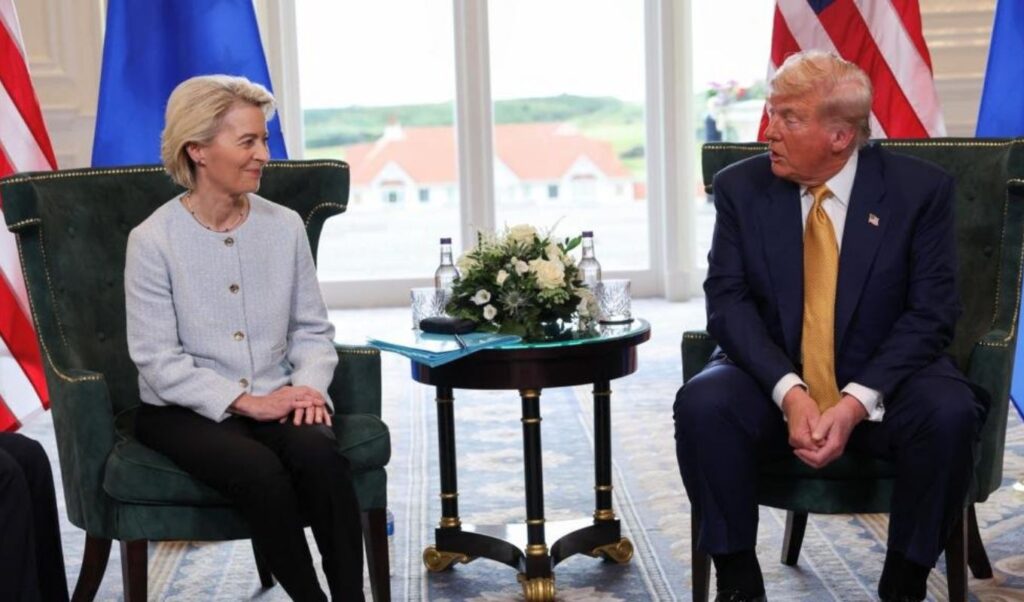The United States and European Union have reached an agreement on tariffs, ending a months-long trade dispute between the world’s two largest trading partners. US President Donald Trump announced the imposition of 15% tariffs on most European imports, including cars, pharmaceuticals, and semiconductors. The decision followed direct talks with European Commission President Ursula von der Leyen at Turnberry, Scotland.
Read: New era for EU and US: The historic trade agreement between Trump and von der Leyen and its terms
From his golf course in western Scotland, Trump stated that the EU committed to purchasing US energy products worth $750 billion over the next three years and investing an additional $600 billion in the American economy.
“All countries will be open to trade with the United States with zero tariffs and agree to buy massive amounts of military equipment,” Trump said characteristically, without providing further details.
While the agreement is not yet considered final, and its full details remain unclear, both Trump and von der Leyen characterized it as historic. The American president presented it as “the biggest deal ever made,” while the Commission chief spoke of “stability” and “predictability.”
Despite the positive statements, CNN notes that while the agreement temporarily removes the risk of a trade war with transatlantic impact, celebrations are restrained, with several critical points remaining unclear and the global economy continuing to face uncertainties.
Trump began talks with von der Leyen on Sunday as Friday’s deadline approached for reaching an agreement to avoid 30% tariffs on European imports. The European Union had sought to maintain basic tariffs at 10%, while Trump had stated that the United States could not reduce the tariff rate below 15%.
German Chancellor Friedrich Merz wrote on X that the hard work of European negotiators paid off. “A trade conflict that would have had serious consequences for Germany’s export-oriented economy was prevented,” he said.
Italian Prime Minister Giorgia Meloni said it was “positive” that a trade agreement had been reached between the EU and US, but added that she needed to see the details, Reuters reported.
Irish Prime Minister Taoiseach Micheál Martin also welcomed the agreement, saying it was “good for businesses, consumers and investors” on X. However, he acknowledged that bilateral trade would become “more difficult” with higher tariffs.
The 15% tariffs on all goods include pharmaceuticals, the number 1 good the US imported from the European Union last year, according to US Commerce Department data. Trump had repeatedly suggested he would impose a 200% tariff on pharmaceuticals manufactured outside the United States from August 1st.
CNN analysis of Trump and von der Leyen agreement: Disaster avoided, but few are celebrating
In its analysis of the agreement, CNN comments: “The United States and European Union avoided the worst-case scenario: a catastrophic, all-out trade war between allies that threatened to raise prices on a wide array of goods and slow two of the world’s largest economies. The framework brought a sense of relief to both sides – but few are celebrating the agreement itself.”
The agreement, which sets a 15% tariff on most European goods entering the United States, is higher than the 10% tariff Trump imposed on April 2nd and significantly higher than the pre-Trump average of about 1.2%. However, it is substantially lower than the massive tariffs Trump threatened if no agreement was reached.
The agreement was delayed as both sides disagreed over America’s insistence on high tariffs on steel and aluminum, tariffs on pharmaceuticals, and the minimum tariff threshold for almost all goods.
Trump and von der Leyen reached a framework agreement – without many details and with reservations – which was nevertheless relieving for both sides.
Both sides avoid the worst
With the agreement’s implementation, two of the world’s largest economies avoided a potentially economically catastrophic trade war. However, there were no celebrations.
“We did it,” Trump said announcing the agreement with von der Leyen. “It’s going to work out very well.”
“I think we achieved exactly the point we wanted to find,” von der Leyen said. “Rebalancing but also enabling trade on both sides. This means good jobs on both sides of the Atlantic, prosperity on both sides of the Atlantic, and that was important to us.”
The United States and Europe “appear to have avoided for now a self-destructive trade war in the largest and deepest trade and investment relationship the global economy knows,” said Jörn Fleck, senior director of the Atlantic Council’s Europe Center.
Nevertheless, details remain unclear. Europe will increase its investments in the United States by $600 billion and commit to buying American energy products worth $750 billion. It eliminates tariffs on a variety of products, including aircraft and airplane parts, semiconductors, generic drugs, and certain chemical and agricultural products.
Maury Obstfeld, senior fellow at the Peterson Institute for International Economics, notes that many of these investments were already in effect.
“There are many things that concern me about this agreement,” Obstfeld said.
However, the basic 15% tariff applies to most goods, so EU member states – and American importers – will have to accept that higher tariffs will increase prices of European products in America.
“You’ll pay more for your European imports. That’s what the agreement means,” said Joe Brusuelas, chief economist at RSM. “This doesn’t enhance trade, it simply imposes a tax on European goods in the United States,” he concluded.




